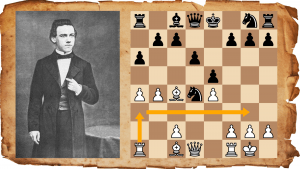
How To Win With The Longest Move In Chess
One of the most promising Dutch junior players of the early 1970s was Roy Dieks from Amsterdam. In the final of the 1972 European Youth Championship, held in Groningen, The Netherlands, Dieks played a crucial game against Tony Miles (who would later become the first British GM). The final move—queen from a1 to h8—illustrates a key point: A longer move in chess is not possible.
Dieks had a phenomenal chess memory. He likely recalled his clash with Miles when, a few years later, he was facing a difficult situation in his game against Philippe du Chattel at the Dutch championship:
Dieks (b. 1956) was one of the most talented players of his generation. He finished second in the 1974 World Junior Championship held in Manila. (First place went to Miles.) I played on the same team as he did for a couple of years. Although he was rather shy and seemed to be always struggling with his mental health, I found him very pleasant company. He had a special type of humor and his sharpness obviously extended to chess. In blitz, he could beat anyone, including strong GMs. He passed away in 2004—much too early.
In probably the most famous endgame study, the legendary Richard Reti (1889-1929) illustrates a fundamental geometrical property of the chessboard: the Pythagorean theorem (the square of the length of the hypotenuse is equal to the sum of the squares of the lengths of the other two sides of a right triangle, or a2 + b2 = c2) does not apply in chess.
The intuitively surprising idea in this study is called the "Reti Maneuver." Although it usually applies to the king in the endgame, it's valid for every piece in chess: the distance between two squares along a diagonal is the same as the distance over a horizontal or vertical file. In other words, moving diagonally is just as fast as moving in a straight line! That's why the king is able to catch the distant h-pawn.

In the Miles-Dieks example, the distance in chess squares (eight) between a1 and h8 is the same as the distance between a1 and a8 (or h1). Pythagoras would've hated chess with a passion. (And I'm not kidding. Hippasus, a contemporary of Pythagoras, was allegedly drowned for discovering that the square root of two cannot be represented as a fraction!)
What, if not Pythagoras, moved Reti to compose his famous endgame study? He may have been inspired to investigate the power of moving diagonally after suffering a painful defeat in a little-known but very instructive simultaneous game in the Netherlands in 1919:
The same idea (protecting h7) was once used by a young Viktor Korchnoi:
Although the distance between a1 and h8 is the same as the distance between a1 and h1, a diagonal "leap" from one corner of the board appears much rarer than its horizontal or vertical cousin. (In my own recorded games, about 1,500 or so, the maneuver occurs just once.)
Perhaps because it feels like such a long and unlikely move, players just don't take it into account that often. Sure, it does occur relatively often in endgames involving queens, such as in this example involving Reti:
Sometimes, even in the endgame, the maneuver can be quite surprising. The former world champion Alexander Alekhine once showed this nicely:
It gets even more rare if you look for examples of a long queen leap early in a game. Here's one, also with relatively few pieces remaining on the board:
The following one is even earlier, and I can't help wondering whether it is again the result of a stubborn refusal to consider the long queen leap:
You might think this accident only happened because the players involved were relatively weak (although White had a rating of 2300+), but you'd be mistaken. Even at the highest level, players can forget about the longest move. Here's proof:
Although Reti shows that the Pythagorean theorem does not apply on a chessboard, queen leaps along the long diagonal are often forgotten, ignored or overlooked.
Don't make the same mistake: Always consider the longest move—or suffer the consequences!



